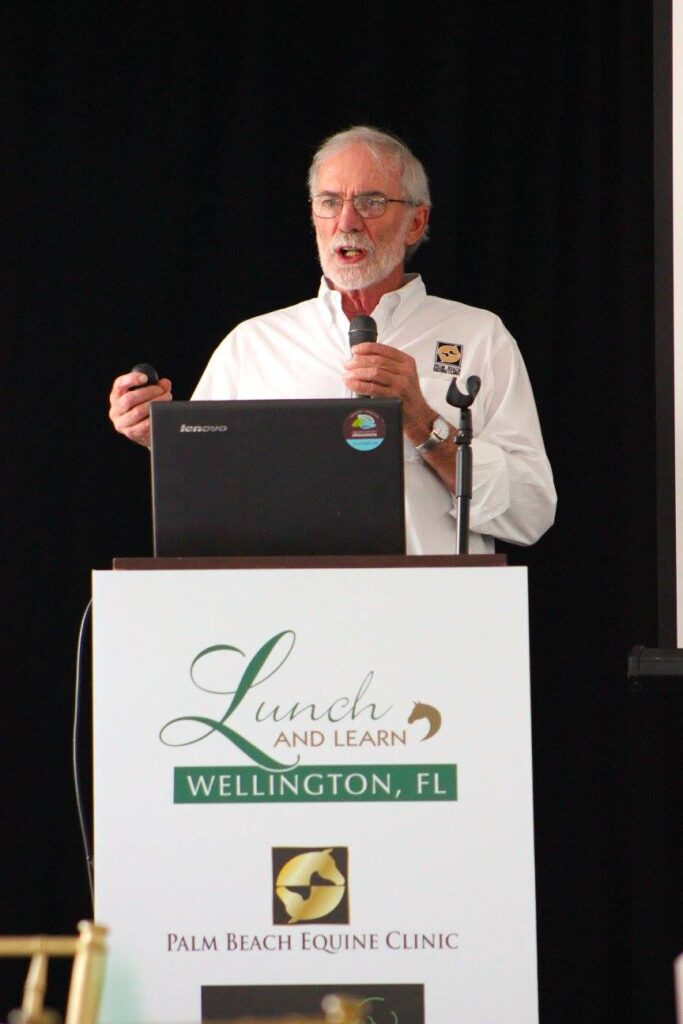Tag: ogrady
Put Your Best Foot Forward
How to Keep Horses’ Hooves Strong Through Summer
Read this article on The Plaid Horse
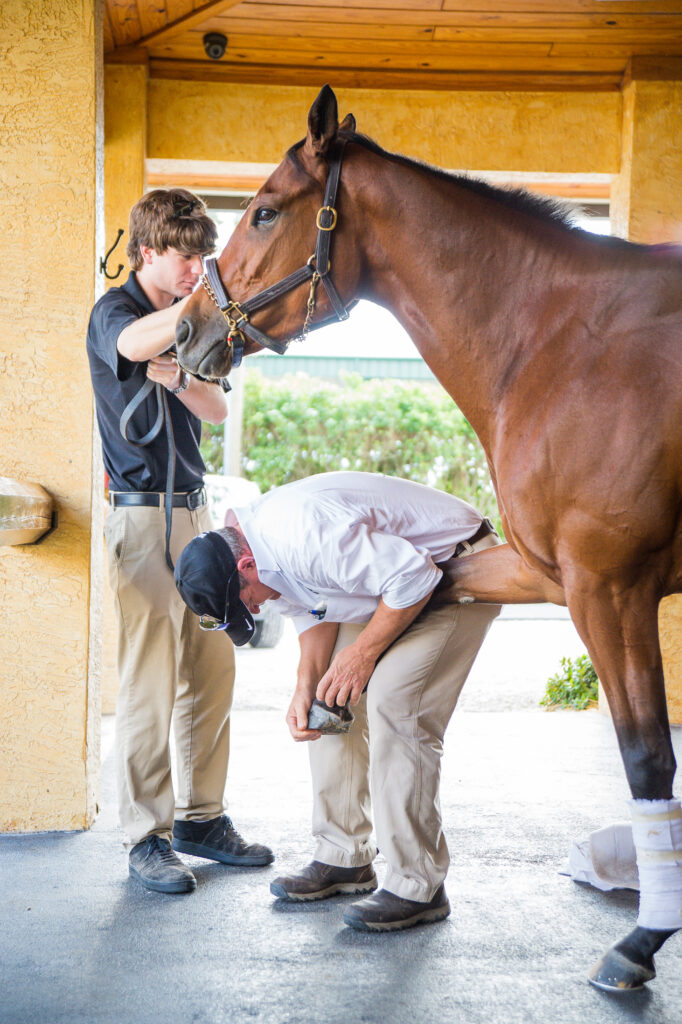
Proper hoof health is hard to achieve any time of year, but during the hot summer months, a solid, healthy hoof is even more difficult to attain due to an increase in moisture in the environment. Each July, the American Farriers Journal dedicates a week of the calendar to recognize farriers for their dedicated commitment to delivering hoof care to horses. To honor our hoof care experts, we spoke with veterinarian and farrier Dr. Stephen O’Grady on how moisture contributes to a weaker hoof infrastructure and offers steps owners and managers can take to help keep moisture away and strengthen horses’ hooves.
Summer can bring scorching temperatures, so we tend to use more water to keep horses cool, both at competitions and at home. In many areas of the country, the humidity levels also increase during this time of year, adding moisture to the air and preventing hooves from drying as quickly. What happens to a hoof with excess water is similar to what would happen to a wooden plank that’s placed in a water trough: it becomes waterlogged, then softens and becomes weaker as a result.
Within a horse’s hoof, there is an exchange of fluids between the outer hoof wall and the inner section of the foot which consists of the bone, blood, and soft tissue structure. This fluid gradient helps keep the hoof wall healthy and promotes overall hoof health. When there is excessive moisture on the outside of the foot, the fluid gradient shifts toward the hoof wall and becomes overloaded with moisture, thus, the foot becomes saturated and the interchange of fluids is no longer effective, affecting a hoof’s mechanical properties.
The lack of flexibility caused by excess moisture creates a softer foot, which ultimately, as the weight of the horse presses down on the hoof, leads to issues such as flattening of the sole, flaring of the hoof wall and hoof wall cracks. A soft foot is also prone to losing shoes, due to its inability to hold nails well. The hoof structure was not designed to withstand as much water as we often subject it to during the summer months. However, there are ways to limit exposure to moisture, even in the hottest temperatures.
It is best to tackle issues that accompany moisture by going straight to the source and minimizing the amount of water that comes in contact with the hooves. This can be accomplished in several ways:
1. Give your horse fewer baths.
Cutting down on how many times per day a horse is hosed can be difficult with competition horses that need to stay clean and that may be exercised, ridden, or shown several times per day. Still, it is important to be strategic about using water, especially on the legs. At home, try to occasionally let your horse air dry in front of the fan if a bath isn’t entirely necessary. Body clipping will help your horse’s heat tolerance this time of year and you may not have to use the hose after every ride.
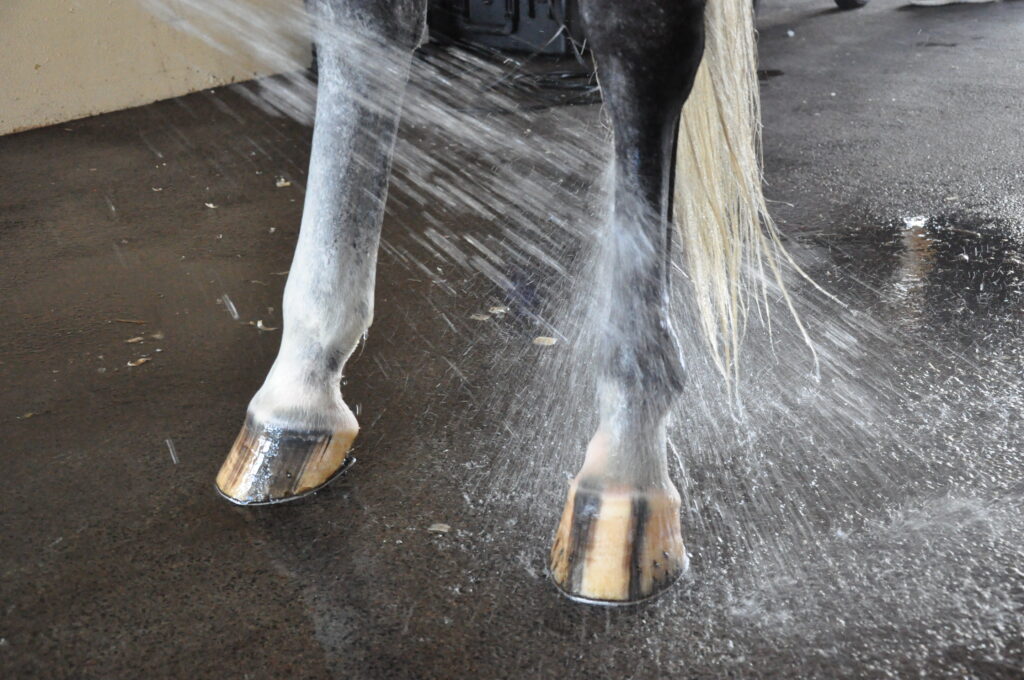
2. Avoid standing water
If you must bathe, be sure the horse isn’t standing in excess water that rises over the hoof capsule. Try to shower off the horse in a dry area so the surface underneath the horse does not contribute to the moisture level. After being bathed, move the horse to a dry surface so their hooves can thoroughly dry.
3. Use hoof shields to direct water away from the hoof.
A good preventative tool to use while hosing is tight-fitting bell boots that cover the hoof and prevent external water from running down onto the hoof. The same effect can be accomplished with a gallon-sized Ziploc bag. Simply cut the bottom of the bag, place the horse’s foot inside, and seal the bag just below the fetlock to prevent excess water from sliding down the hoof.
4. Stand the horse in sawdust.
Sawdust and similar materials have a drying effect on hooves. If hooves become saturated for any reason, let the horse stand in deep sawdust to extract the moisture. Shavings would work also, but sawdust is the most effective for absorbing moisture.
5. A shellac-type hoof dressing product can help prevent the hoof from absorbing too much water if applied before baths or turnout.
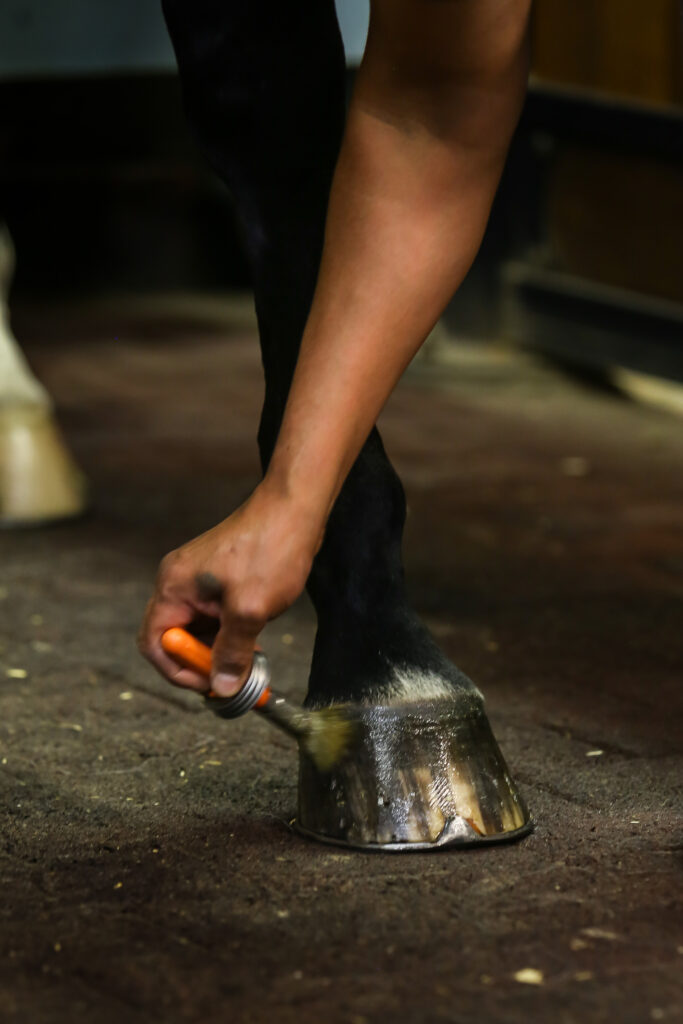
The majority of hoof dressings are intended for this purpose, however. Ask your farrier or veterinarian to recommend options that will do the job when used one to two times per week. Boric acid powder can also be applied to horses’ feet once or twice a week, serving as an astringent for the hoof.
6. Avoid turning out early in the morning.
When humidity is high, the grass at dawn will have a high dew level, meaning horses will be standing on wet surfaces during the first hours spent outside. Though temperatures are cooler as the sun is still rising, for overall hoof health it’s best to wait until the grass has dried.
7. Farriery may need to be changed during the summer months to compensate for the increase in moisture.
Open the lines of communication between veterinarian and farrier. Veterinarians and farriers often do not communicate regarding a particular horse. This is a crucial step to ultimate hoof care. Each professional has a reason behind their decisions, and if the two work together as a team, the horse has a much higher chance of achieving optimal hoof health than if they each operated on their own agenda.

Achieving a healthy hoof is not solely a farrier’s job; it is a whole team effort and requires dedication and attention. By implementing these recommendations into your horse care routine, you can play a role in how moisture affects your horse’s hooves. When considering the effects of excessive moisture on the hoof wall, it’s important to understand there are other factors involved, including the age of horse, breed, genetic makeup, foot conformation, and current farriery practices. With open communication and implementing these measures as a team, you are on the right track to achieving a stronger and overall healthier hoof.
Many a seasoned horseman will admit that success in any discipline of horse sport is dependent on healthy hooves. Palm Beach Equine Clinic proudly offers the most advanced equine podiatry services to referring veterinarians and clients.

As the winter show season reaches its peak in South Florida, hoof care is paramount and the importance of good quality hoof care in the competition horse can’t be denied. The equine hoof is unique, as it is comprised of a group of biological structures that follow the laws of biomechanics. To that end, the farrier is a major asset during the show season as he or she can be proactive in maintaining the health of a horse’s foot and help to prevent lameness.
There are three very important aspects of farriery science that the farrier will use to keep any horse sound:
1. The Trim
Trimming the foot in conjunction with the size and placement of the horseshoe. Typically, a farriery session will begin with an evaluation of the conformation of each hoof from the front, side, and behind to observe the height of the heels. Next, the farrier should observe the horse in motion to see whether the horse’s foot lands heel first, flat or toe first. Regarding the trim, many farriers no longer use the term ‘balance the foot’ – which has no meaning – and have begun to use guidelines or landmarks when approaching the trim.
The guidelines used are:
- Trimming to achieve a straight hoof-pastern axis
- Using the widest part of the foot which correlates to the center of rotation
- Trimming the palmar foot (heels) to the base of the frog or to the same plane as the frog.
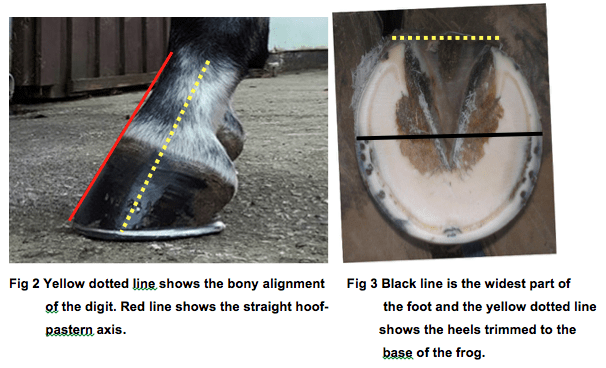
A closer look at these three guidelines, which are all interrelated, will help to show their importance. If the dorsal (front) surface of the pastern and the dorsal surface of the hoof are parallel or form a straight line, then the bones of the digit (P1, P2, P3) are in a straight line, and the force from the weight of the horse will go through the middle of the joint. Furthermore, and equally important, if the hoof-pastern axis is straight, the weight will be distributed evenly on the bottom of the foot.
2. Center of rotation (COR)
As the COR is located a few millimeters behind the widest part of each foot, it allows the farrier to apply appropriate biomechanics to each foot. The foot is trimmed in approximate proportions on either side of the widest part of the foot, which provides biomechanical efficiency.
3. The Heel

One should trim the palmar section of the foot to the base of the frog or trim such that the heels of the hoof capsule and the frog are on the same plane. Adherence to this guideline keeps the soft tissue structures (frog, digital cushion, ungula cartilages) within the hoof capsule, which are necessary to absorb concussion and dissipate the energy of impact. We must remember that heels do not grow tall, they grow forward. If we allow the heels to migrate forward, the soft tissue structures will be forced backward out of the hoof capsule. Furthermore, as the heels migrate forward, the weight is placed on the bone and lamellae, thus bypassing the soft tissue structures of the foot. Allowing the heels to migrate forward also decreases the ground surface of the foot.
These three guidelines can be applied to any foot and they serve as a basis for maintaining a healthy foot, as well as a basic starting point for applying farriery to a horse with poor foot conformation or one with a distorted hoof capsule.
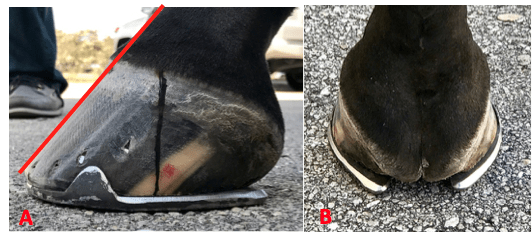
Palm Beach Equine Clinic is proud to have beneficial consulting relationships with many equine medical professionals throughout the country, including Dr. Stephen E. O’Grady, DVM, MRCVS, of Virginia Therapeutic Farriery. Dr. O’Grady provides advanced services in equine podiatry, offering comprehensive diagnosis, treatment, and maintenance for a variety of foot conditions using medical therapy as well as therapeutic shoeing.
Palm Beach Equine Clinic features the services of Dr. O’Grady for consultations year-round. With the experience and expertise of its world-class veterinarians, in addition to Dr. O’Grady’s wealth of knowledge, the Palm Beach Equine Clinic is able to provide the very best in advanced treatments in equine podiatry.
Equine Podiatry Services

There is no structure on the horse that is as susceptible to injury, disease, or “wear and tear” than the equine foot. Proper, timely hoof care can often make the difference between a sound performance horse and one with chronic lameness. Some of the problems that Dr. O’Grady consults on include:
- Hoof Diseases
- Laminitis
- Severe Infections
- Advanced White Line Disease
- Therapeutic Horseshoeing
- Hoof Wall Defects
- Juvenile Orthopedics
Equine podiatry requires extensive knowledge of hoof anatomy, physiology, biomechanics and diagnostic imaging, as well as the farrier skills necessary to implement specialized shoeing. The combination of being educated as both a veterinarian and a professional farrier allows Dr. O’Grady to treat each foot problem with an understanding of the medical physiology and the mechanics involved. This blending of the two professions allows him to comprehensively diagnose, treat, and design a maintenance plan for a variety of foot conditions using medical therapy as well as therapeutic farriery. Dr. O’Grady also works together with referring veterinarians on difficult cases to discuss and assist with a plan that works for all parties.
Diagnostic Imaging for Equine Podiatry Cases
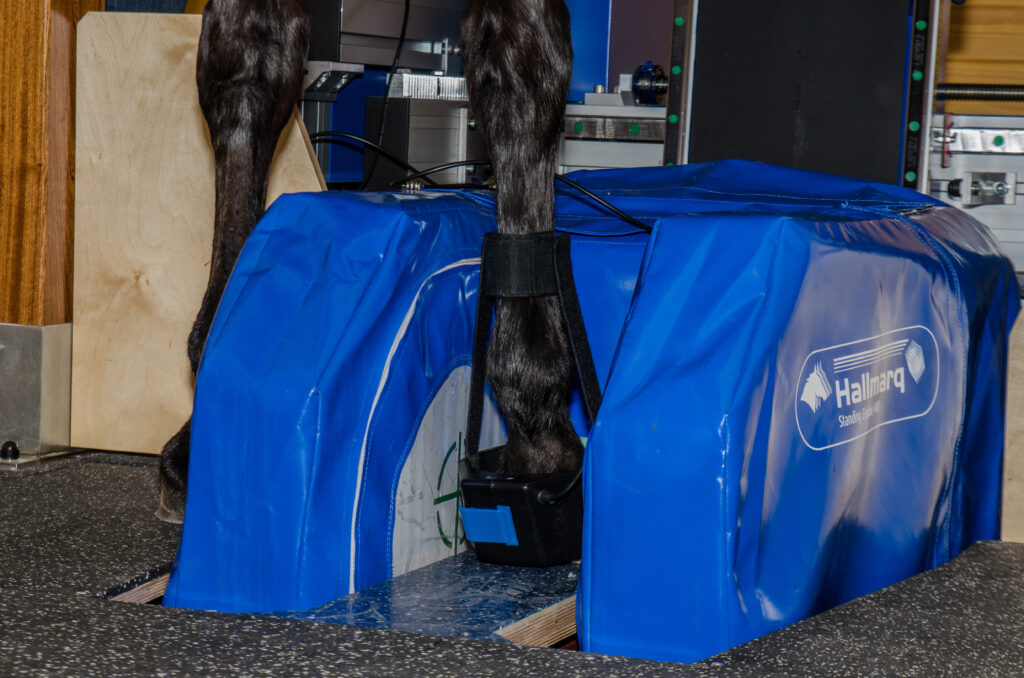
The advanced imaging equipment at Palm Beach Equine Clinic, in combination with Dr. O’Grady’s expertise, allow for comprehensive diagnosis and treatment of all hoof-related conditions. Palm Beach Equine Clinic offers a Hallmarq standing MRI that can provide a detailed diagnosis of any foot issues. Medical therapy, such as surgery and various medications, are often combined with therapeutic farriery for the best possible results. Dr. O’Grady’s methodology centers around using the basic principles of farriery, and when necessary, combining these principles with advanced technology and improved farrier products available on the market.
Equine podiatry consultations can be used for a variety of complicated hoof conditions where the problem is severe, chronic, and non-responsive to the present treatment. Hoof problems can include severe injuries, acute or chronic laminitis, hoof wall defects (non-healing quarter or toe cracks), hoof capsule distortions (club feet, long toe under-run heels), and severe hoof disease (infections, WLD, canker). There are many hoof-related problems that benefit from the advanced technology and farrier techniques available today.
Foot soreness, especially for jumpers, become more noticeable as the winter equestrian season winds down in Florida, according to well-respected veterinarian and farrier Dr. Stephen O’Grady of Palm Beach Equine Clinic.

Foot Soreness Issues Surfacing Toward the End of Winter Competition Season
Dr. O’Grady has been treating horses for 45 years across the country. He also travels extensively all over the world, teaching and training other veterinarians and farriers on therapeutic farriery solutions. It’s obvious to Dr. O’Grady why foot soreness and problems are more common later in the horse show season.
“When horses arrive in Wellington, Florida, in December, foot care starts with bar shoes, pads, pour-ins, etc. as a form of prevention for the busy three months. Perhaps it would be more appropriate to start the competition season by doing a conservative trim, leave horn on the bottom of the foot, and make sure the proper size shoe is selected. The various farrier products may actually add pressure to the structures in the beginning of the season” says Dr. O’Grady.
“When it comes around to March, the structures of the foot have been compromised by the intensity of the competition schedule. The protective farrier products have already been used and there’s nothing more to absorb the shock and energy at the end of the season.”
Preventing Foot Soreness in Competition Horses
Dr. O’Grady adds that it is okay to use different medications and anti-inflammatories as long as the proper dosages and rules are followed as prescribed. But to properly fix foot problems, he has one sure solution.
“Time is the best cure,” Dr. O’Grady says. “The feet are the slowest structures on the horse to recover. There isn’t a magical fix.”
However, Dr. O’Grady has an idea that might help if you cannot give your horse sufficient rest despite the numerous classes and repetitive nature of the show schedule.
As the season wears on, whether it’s WEF or HITS, Dr. O’Grady believes that decreasing the amount of warm up, schooling and lunging makes a world of difference in protecting the hooves.
“But if the feet are sore, the feet are sore,” adds Dr. O’Grady. “There’s no quick fix. It’s all about prevention.”
Snowballing Effects of Foot Soreness
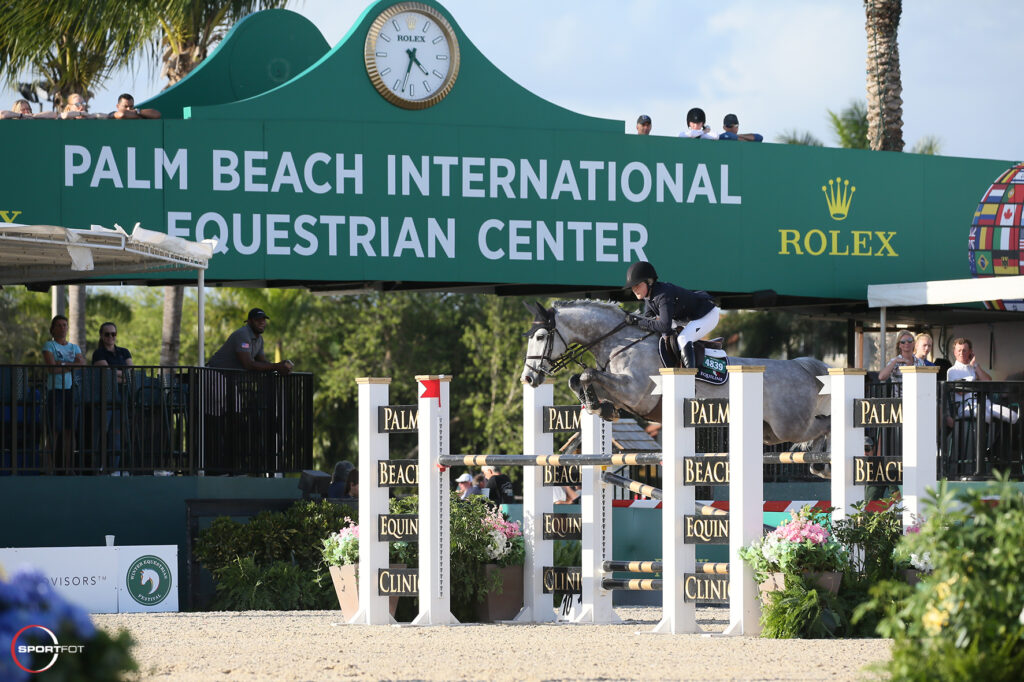
Sore feet can cause numerous problems elsewhere, according to Dr. Robert Brusie, head surgeon at Palm Beach Equine Clinic.
“The horses with sore feet tend to land funny, which can cause strained suspension ligaments or tendons,” says Dr. Brusie. “There also could be sore heels. Sore feet tend to make them short-strided and that could lead to a sore back and or a sore neck.”
Dr. Brusie says one way to notice a horse with sore feet, especially among jumpers, is their reluctance to jump the fences.
“That can be hard on the riders, too,” adds Dr. Brusie.
The foot is the closest to the environment and if you have a sore-footed horse, it could lead to lameness and poor performance, according to Dr. Brusie. Another possibility that could lead to sore feet is being too wet.
“Horses that are to show or play (polo) sometimes get two or three baths a day,” explains Dr. Brusie. Coupled with rings that are sprayed with water to help the footing can lead to problems, he said.
Both Dr. O’Grady and Dr. Brusie believe that taking proper care of your horse’s feet early helps the horses in the long run by eliminating other problems.

